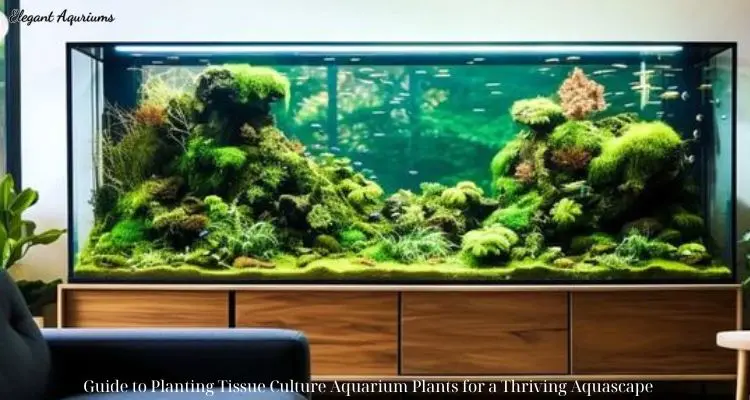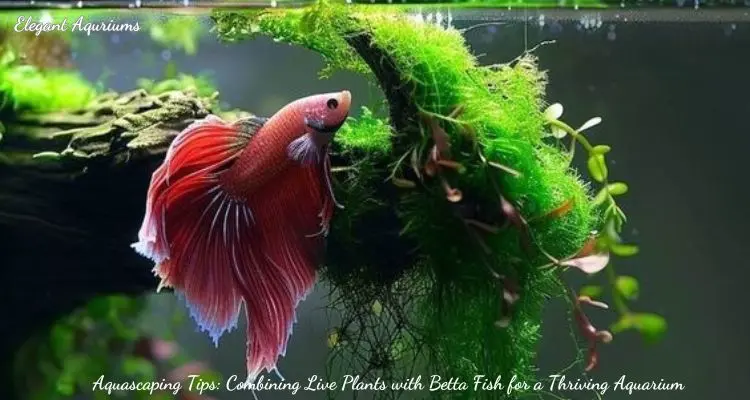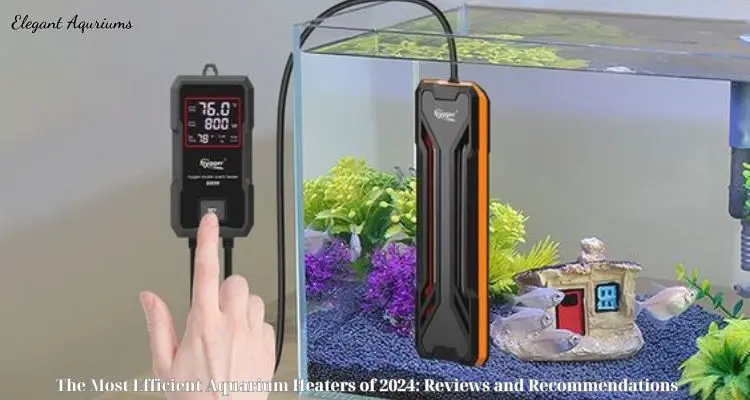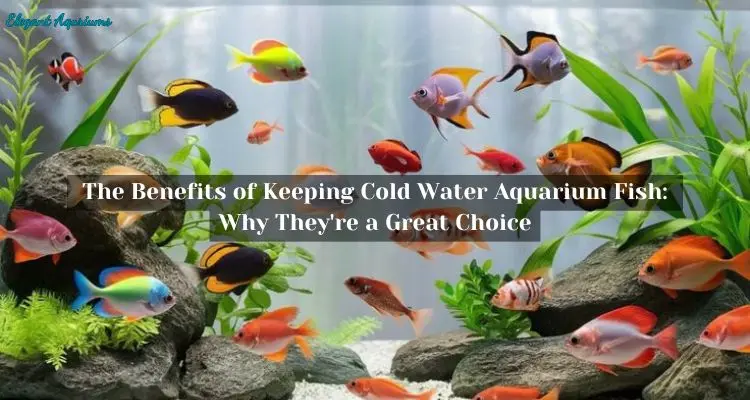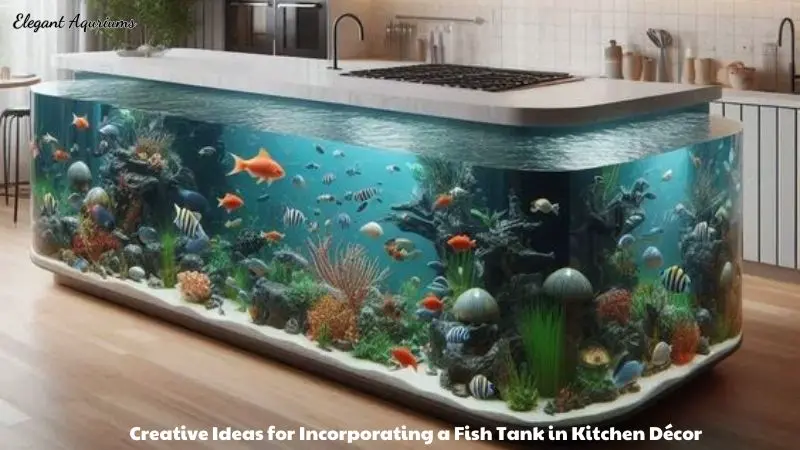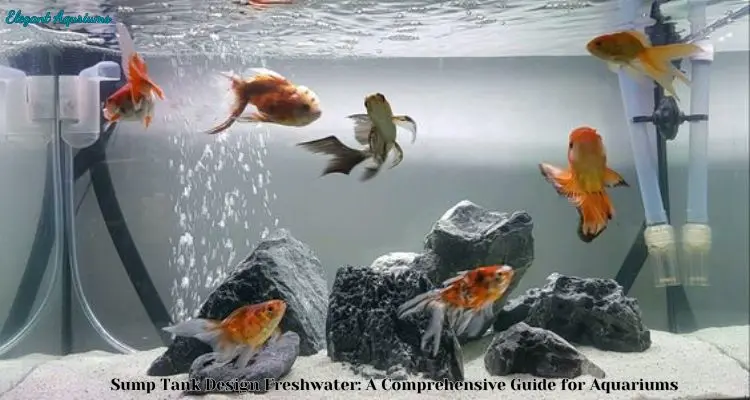Aquarium accessories and decorations
Guide to Planting Tissue Culture Aquarium Plants for a Thriving Aquascape
Aquascaping is an art form that combines creativity and horticulture, resulting in stunning underwater landscapes. One of the key elements of a successful aquascape is the selection and maintenance of aquarium plants. In recent years, planting tissue culture aquarium plants has become increasingly popular among aquarists due to their high quality, pest-free nature, and ease of use. Elegant Aquriums will walk you through the process of planting tissue culture aquarium plants to create a thriving and beautiful aquascape.
Understanding Tissue Culture Aquarium Plants
What Are Tissue Culture Aquarium Plants?
Tissue culture aquarium plants are grown in a laboratory setting using advanced biotechnology. Small plantlets are propagated from a mother plant in sterile conditions, ensuring that they are free from pests, algae, and diseases. These plants are often sold in small cups filled with a nutrient-rich gel, making them an ideal choice for hobbyists looking to create a pristine aquascape.
Benefits of Using Tissue Culture Plants
- Pest-Free: Unlike traditional potted plants, tissue culture plants are grown in a sterile environment, making them free from pests such as snails, algae, and pathogens. This ensures a healthier start for your aquascape.
- High Quality: Tissue culture plants are propagated from strong and healthy parent plants, resulting in robust and vibrant growth. They often exhibit superior color and growth patterns compared to other types of plants.
- Ease of Planting: These plants are small and compact, making them easy to handle and plant in your aquarium. They quickly adapt to their new environment and begin growing once planted.
- Wide Variety: Tissue culture plants are available in a wide range of species, including carpeting plants, stem plants, and epiphytes, allowing for endless possibilities in aquascape design.
Popular Types of Tissue Culture Aquarium Plants
- Carpeting Plants: Ideal for creating lush, green carpets on the substrate, popular choices include Hemianthus callitrichoides (Dwarf Baby Tears) and Eleocharis parvula (Dwarf Hairgrass).
- Stem Plants: These plants add height and structure to your aquascape. Examples include Rotala rotundifolia and Ludwigia palustris.
- Epiphytes: These plants attach to hardscape elements such as rocks and driftwood. Popular epiphytes include Anubias nana and Microsorum pteropus (Java Fern).
Preparing for Planting Tissue Culture Aquarium Plants
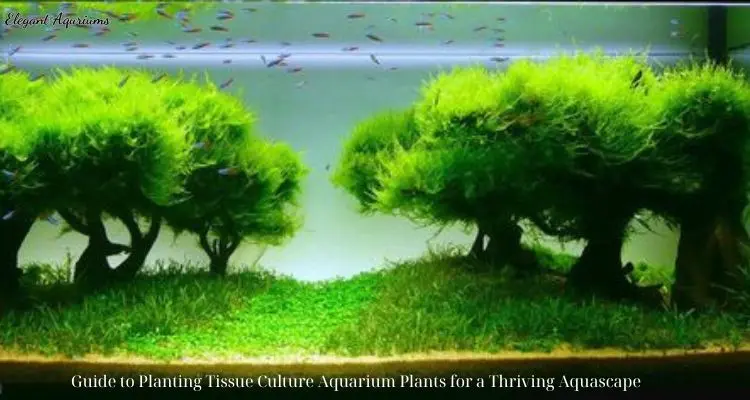
Choosing the Right Substrate
The substrate is a crucial element in the success of your aquascape, as it provides essential nutrients and support for your plants. When planting tissue culture aquarium plants, it’s important to choose a substrate that promotes healthy root development.
- Nutrient-Rich Substrate: Choose a substrate specifically designed for planted aquariums, such as Aqua Soil or similar products. These substrates contain essential nutrients like iron, potassium, and nitrogen, which support plant growth.
- Grain Size: The grain size of the substrate should be small enough to allow delicate roots to penetrate easily. Avoid using coarse gravel, as it can hinder root development.
- Layering: Consider layering your substrate with a base layer of nutrient-rich soil, followed by a top layer of fine gravel or sand. This helps provide a stable foundation for your plants while promoting nutrient uptake.
Selecting Hardscape Elements
Hardscape elements, such as rocks and driftwood, provide structure and visual interest to your aquascape. When planting tissue culture aquarium plants, hardscape elements also serve as anchor points for epiphytes and other plants that require attachment to surfaces.
- Choosing the Right Materials: Select hardscape materials that complement the overall theme of your aquascape. Rocks like Seiryu Stone and Dragon Stone are popular choices, as they add texture and contrast to the landscape. Driftwood adds a natural, organic feel and serves as an excellent anchor for epiphytic plants.
- Arranging Hardscape: Plan your hardscape layout before planting to ensure a balanced and harmonious design. Consider the rule of thirds, focal points, and depth to create a visually appealing aquascape.
Setting Up Lighting and CO2
Lighting and CO2 are essential factors that influence the growth and health of your tissue culture plants.
- Lighting: Choose a lighting system that provides the appropriate intensity and spectrum for plant growth. LED lights are a popular choice for aquascapes due to their energy efficiency and customizable settings. Ensure that your light source covers the entire tank and provides sufficient light for photosynthesis.
- CO2 Injection: CO2 is crucial for photosynthesis and the overall health of your plants. Consider installing a CO2 injection system, especially if you’re planning to grow high-demand plants. Maintain a consistent CO2 level of around 20-30 ppm for optimal growth.
Preparing the Aquarium
Before planting tissue culture aquarium plants, ensure that your aquarium is properly set up and ready for planting.
- Filling the Aquarium: Fill your aquarium with dechlorinated water, leaving enough space to easily access the substrate for planting. If you’re using a nutrient-rich substrate, avoid disturbing it during the filling process.
- Temperature and Water Parameters: Ensure that the water temperature and parameters are suitable for the plants you’ve chosen. Most tissue culture plants thrive in temperatures between 72-82°F (22-28°C) and a pH range of 6.0-7.5.
Planting Tissue Culture Aquarium Plants
Step-by-Step Planting Process
- Unpacking the Plants:
- Carefully remove the plants from the tissue culture cup.
- Rinse off the nutrient gel under lukewarm water to remove any residue. It’s important to be gentle to avoid damaging the delicate roots.
- Dividing the Plantlets:
- Gently separate the plantlets into smaller portions, using tweezers or your fingers.
- Divide the plantlets into manageable sections, depending on the size of your aquarium and the desired layout.
- Planting Carpeting Plants:
- Use tweezers to plant the individual plantlets into the substrate.
- Plant them closely together to encourage faster carpeting. Ensure the roots are fully submerged in the substrate.
- Planting Stem Plants:
- Insert the stem plants into the substrate, making sure to bury the roots securely.
- Space the stems according to the desired density, keeping in mind the growth pattern of the plants.
- Attaching Epiphytes:
- Attach epiphytic plants like Anubias or Java Fern to rocks or driftwood using aquarium-safe glue or fishing line.
- Position them strategically within your aquascape to enhance visual appeal.
- Final Adjustments:
- Once all plants are in place, make any necessary adjustments to the layout and ensure that the plants are secure.
- Fill the aquarium with water to the desired level, taking care not to disturb the newly planted areas.
Tips for Success
- Avoid Overcrowding: While it’s tempting to fill the tank with plants, avoid overcrowding to ensure proper water circulation and light penetration.
- Maintain Consistent Conditions: Stability is key to the successful establishment of tissue culture plants. Avoid drastic changes in lighting, CO2, or water parameters during the initial stages.
- Monitor Growth: Regularly check the progress of your plants and adjust lighting, CO2, and nutrient levels as needed. Prune overgrown areas to maintain the desired look and prevent shading of lower plants.
Post-Planting Care and Maintenance
Initial Care After Planting
- Observe Plant Health: In the first few weeks, monitor your plants closely for signs of adaptation or stress. Yellowing leaves or slow growth may indicate a need for adjustments in lighting or nutrient levels.
- Light Adjustment: Gradually increase the lighting intensity over time to allow plants to acclimate to their new environment. Start with a shorter photoperiod and increase it as the plants establish themselves.
- CO2 and Fertilization: Maintain consistent CO2 levels and start dosing liquid fertilizers to provide essential nutrients. Begin with a lower dose and increase gradually as the plants start to grow.
Ongoing Maintenance
- Regular Water Changes: Perform regular water changes to maintain water quality and remove excess nutrients. A weekly 20-30% water change is recommended for planted aquariums.
- Pruning and Trimming: As your plants grow, regular pruning and trimming are necessary to maintain the desired shape and prevent overcrowding. Prune carpeting plants to encourage dense growth and remove any dead or decaying leaves.
- Nutrient Management: Monitor nutrient levels and adjust fertilization as needed. A balanced supply of macronutrients (nitrogen, phosphorus, potassium) and micronutrients (iron, trace elements) is essential for healthy plant growth.
- Algae Control: Keep an eye out for algae growth, especially in the early stages of planting. Adjust lighting, CO2, and nutrient levels to prevent algae outbreaks. Consider introducing algae-eating fish or invertebrates as part of your aquarium’s ecosystem.
Troubleshooting Common Issues
Slow Growth or Yellowing Leaves
- Possible Causes: Insufficient lighting, inadequate nutrients, or low CO2 levels.
- Solutions: Increase light intensity, adjust fertilization, and ensure consistent CO2 injection. Test water parameters to identify any deficiencies.
Algae Outbreaks
- Possible Causes: Excess nutrients, high light intensity, or imbalanced CO2 levels.
- Solutions: Reduce lighting duration, increase water changes, and balance nutrient dosing. Introduce algae-eating species like Amano shrimp or Otocinclus catfish.
Melting or Decaying Plants
- Possible Causes: Shock from transplanting, poor water quality, or improper planting techniques.
- Solutions: Ensure that plants are properly anchored in the substrate, adjust water parameters to suitable levels, and provide stable conditions for the plants to recover. Consider trimming away any decayed portions to encourage new growth.
Stunted Growth or Fading Colors
- Possible Causes: Nutrient deficiencies, particularly in trace elements like iron, or insufficient CO2.
- Solutions: Increase the dosage of liquid fertilizers, particularly those containing iron, and ensure that CO2 levels are consistent. Consider using root tabs for nutrient-heavy plants to provide a direct supply to the roots.
Floating Plants
- Possible Causes: Inadequate anchoring during planting, fish disturbance, or strong water currents.
- Solutions: Replant floating plants with the help of tweezers, ensuring that the roots are fully submerged in the substrate. Adjust water flow to prevent plants from being uprooted, and avoid disturbing the plants during maintenance.
Plant Melting or Discoloration After Introduction
- Possible Causes: Transition shock from tissue culture to aquarium conditions or poor acclimatization.
- Solutions: Be patient as plants acclimate to their new environment. Ensure consistent conditions and consider reducing lighting intensity temporarily to ease the transition. Remove any dead or decaying leaves to prevent them from polluting the water.
Enhancing Your Aquascape with Tissue Culture Plants
Creating a Balanced Aquascape
A thriving aquascape is not only about healthy plants but also about creating a visually appealing environment. Consider the following tips to enhance your aquascape using tissue culture aquarium plants:
- Layering and Depth: Use a combination of foreground, midground, and background plants to create depth and dimension in your aquascape. Carpeting plants in the foreground, taller stem plants in the background, and medium-height plants in the midground can help achieve a balanced layout.
- Contrast and Color: Select plants with varying leaf shapes, colors, and textures to create contrast and visual interest. For example, pairing bright green carpeting plants with darker-leaved stem plants can create a striking contrast that enhances the overall aesthetics of the aquascape.
- Focal Points: Incorporate hardscape elements and strategically place focal plants to draw the viewer’s eye to specific areas of the aquascape. Consider using unique or eye-catching plants, such as red or purple varieties, as focal points.
Combining Tissue Culture Plants with Traditional Plants
While tissue culture plants offer numerous benefits, combining them with traditional aquarium plants can add diversity to your aquascape. When mixing plant types, keep the following in mind:
- Compatibility: Ensure that the plants you select have similar light, CO2, and nutrient requirements. This will make it easier to maintain a balanced environment.
- Planting Order: Start by planting tissue culture plants, which are often smaller and more delicate, before adding larger, more established plants. This prevents the smaller plants from being overshadowed or damaged during planting.
- Maintenance Considerations: Regularly monitor the growth of both tissue culture and traditional plants. Prune and trim plants as needed to prevent overcrowding and ensure that each plant receives adequate light and nutrients.
Adding Invertebrates and Fish
Once your tissue culture plants are established, consider adding invertebrates and fish to complete your aquascape. Choose species that are compatible with the plants and won’t disturb them:
- Algae Eaters: Invertebrates like Amano shrimp, nerite snails, and Otocinclus catfish can help control algae growth without damaging the plants.
- Small Fish: Species like neon tetras, guppies, and bettas are ideal for planted tanks. They add color and movement to the aquascape without uprooting or eating the plants.
- Avoid Plant-Eaters: Be cautious when selecting fish species, as some, like goldfish and certain cichlids, may eat or uproot the plants. Stick to species known for being plant-friendly.
Long-Term Care for Your Aquascape
Maintaining Plant Health Over Time
- Regular Pruning: As your plants grow, regular pruning is essential to maintain the desired shape and prevent overcrowding. Trim stem plants to encourage bushier growth and remove any dead or decaying leaves.
- Fertilization Routine: Establish a consistent fertilization routine to supply your plants with the nutrients they need. Consider using a combination of liquid fertilizers and root tabs to target both water column and substrate nutrients.
- CO2 Management: Maintain consistent CO2 levels to promote healthy growth. Monitor CO2 levels regularly and adjust as needed to accommodate changes in plant mass and growth rates.
Preventing Algae and Pests
- Algae Control: Keep algae in check by balancing light, CO2, and nutrients. Regular water changes and the introduction of algae-eating invertebrates can also help manage algae growth.
- Pest Monitoring: Although tissue culture plants are pest-free, it’s important to monitor your tank for any signs of pests that may be introduced through other means, such as new fish or plants. Quarantine new additions and inspect them thoroughly before introducing them to your aquascape.
Adapting to Seasonal Changes
- Temperature Fluctuations: Be mindful of seasonal temperature changes that may affect your aquarium. Consider using a heater or chiller to maintain a stable temperature range, especially if you live in an area with extreme seasonal variations.
- Light Duration: Adjust the photoperiod as needed to match seasonal changes. During winter months, you may need to increase light duration to compensate for shorter daylight hours, while in summer, reducing light duration can help prevent algae growth.

